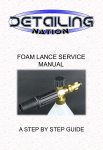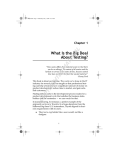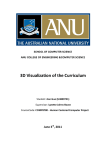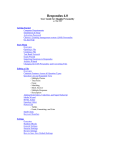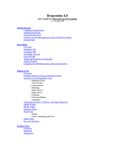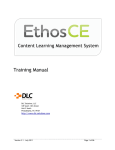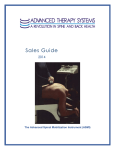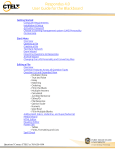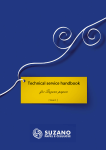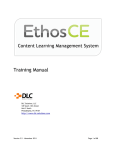Download ROUGH EDITED COPY PEPNET THINK TANK 2 MARCH 24, 2010
Transcript
ROUGH EDITED COPY PEPNET THINK TANK 2 MARCH 24, 2010 MOODLE PRESENTATION CAPTIONING PROVIDED BY: ALTERNATIVE COMMUNICATION SERVICES, LLC PO BOX 278 LOMBARD, IL 60148 * * * ** This is being provided in a rough-draft format. Communication Access Realtime Translation (CART) is provided in order to facilitate communication accessibility and may not be a totally verbatim record of the proceedings. ***** >> Denise Kavin: Hello, and welcome to the third presentation on the second day of the PEPNet Webcast online media. I would like to remind participants that in the interest of time we have decided to turn to technology to provide each participant and presenter with an easy-to-use environment to ask questions, receive answers, and stimulate discussions as they relate to the presentations given over the past two days. Please refer to the confirmation email you received which provides details where you can sign in to ask your questions. The LearnCentral social networking site is now available for your use. This presentation will focus on Moodle, a Learning Management System. Our presenter is John Brandt. Who is a technology and learning consultant to the Maine state assistive technology program known as CITE. Welcome, John. >> Thank you and good afternoon. I'm reminded that when one does public speaking or teaches you should never try to do your class right after lunch because of the sugar that's digested in your system, sleep will soon follow. So if you fall asleep and take a little nap during this presentation I'll completely understand it. Thank you for the opportunity to present today about Moodle and about Learning Management Systems. And I thought we would begin by just familiarizing you with some of our goals today. First of all, I'm going to assume that some of this will be new for some people and for some of you it will be old hat. So I apologize those of you who know this already, but for those who are struggling to understand some of these concepts, hopefully this will make some sense to you. So we'll talk a little bit about Learning Management Systems, some of the vocabulary and concepts behind those, we'll familiarize you with Moodle although this will be a very tertiary, very minimal presentation about Moodle. And I'd like to spend some time talking specifically about issues related to accessibility. So we start the naming of parts. We have used some of these terms already today and I want to make sure we're all on the same wavelength when we talk about this. We talk about Distance Learning, so situations where the learner and teacher are in two different locations. Generally speaking we're talking about Asynchronous Learning when we talk about the teacher and learning, so it's not realtime. Although in all of these cases Moodle could be used as a synchronous tool and done I guess relatively small distance. You could use it on a campus with folks in the same locale. Learning Management Systems it's a term that there are many similar terms that people use. Basically this is a system I like to refer to as a school in a box. This is an application where all of the information, all of the things -- all the tools you need to be able to register students, deliver courses, grade students, provide feedback to students are all built in. And you can even do things like create a student lounge, a student bookstore, all kinds of things out of a Learning Management System. We're going to be talking about an Open Source Software solution and I'll explain a little more about what that is. But basically we're talking about software, one of the words that people use, we put in front of Open Source Software is it's free which is an important thing, given budgets. We'll also be talking about usability and accessibility. And usability in the broadest sense is making sure that any application or any computer program or technology that we're using works well with individuals. So it's that machine user interface that's important. And a subset of usability is accessibility, and that's specifically usability for people with disabilities. Okay. The Learning Management Systems come in commercial versions and Open Source versions. The difference between the two is the commercial applications typically work out of the box. These are -- if you purchase something from Microsoft or Adobe, you'd pay them a lot of money, you install it on your computer and you expect it to work. Unlike the commercial products, Open Source frequently requires some tinkering and some putting things together and making them work. So it's sometimes not for the feint of heart. And with commercial applications you also get a fair amount of customer support that comes as part of the fee that you pay. And with Open Source, although there is usually a community of many, many people that know the software and work with the software, you may have to rely upon some kind of a discussion group or email support system and not be able to pick up the phone and ask what do I do now. On the other side, the Open Source, as I've said, is free. It usually is a very, very large development group. Most application development these days is modular so that nobody sits down and starts writing code from line 1 through line 1050. We usually take modules that other people have corrected, sort of like the erector set for those of you who know what they are, or Legos who know what they are, and put the pieces together. And there's usually some kind of a ringmaster who makes sure all those pieces work together. That's what the Open Source community does. So you find people who are developing things in Australia, people developing things in Germany, people developing things in South America, people developing things in the United States, all pulling pieces together. And what I have found in working with the Open Source community is they get it. They understand usability and accessibility much better than the commercial operators. Some of the commercial programs that are available that are Learning Management Systems are listed on this slide. I don't read them all to you. The one you're probably most familiar with is the WebCT BlackBoard and you may have had a workshop on that already. I'm familiar with BlackBoard, I'm familiar with the eCollege product. The others I'm not as familiar with. But these are all commercial Learning Management Systems and they're usually hosted solutions, although you can sort of buy the software and host it yourself. But generally when you purchase the program, you are purchasing it in a way that it comes with hosting. On the Open Source side we have Moodle obviously is one I am going to be talking about today but some of these other products as well. I know I've worked with ATutor, a program developed at the university of Toronto and is highly -- highly accessible to people with disabilities. So why do I like Moodle and why am I here today? Moodle is one of the oldest of the Learning Management Systems, one of the first ones developed. It may have been ten years ago and ten years is a lifetime in web application world. When I did this slide a year and a half ago the -- that line it says most commonly used, it had 16 million users. So it's more than doubled in 18 months. There's over 33 million users and that number is increasing every day. I have found it to be completely accessible out of the box, so to speak, so that when you install a Moodle, it will be fully accessible to all people with all disabilities including people using different kinds of assistive technology devices. It's obviously very popular and the research that has been made available has shown that it works at least as good as any of the commercial applications and some would suggest even better. Some of the reasons why I don't like the commercial products are kind of the opposite of that. I could tell you horror stories about some of the commercial applications. Some of them you've presented over the past two days about where it may work well with students, so to speak, or sort of the user, end user, but if you tried to administer the application and you are an assistive technology user, you are out of luck. And I've heard some horror stories about that. What I've found in the commercial application world is that many of those companies, though they speak lip service to accessibility, either don't really get it or they're not really committed to it. That they can see the loss of maybe a 10, 12, 15% market share as being acceptable odds compared to the millions of dollars it would cost them to retrofit or redo the software. And so they're not really receptive to change. And this has happened with vendor after vendor after vendor. So it's not any one company. And then you have to ask yourself for what you're going to get, if you're going to have to do a lot of adaptation with the end product and maybe sure all students can access this information, is it really worth all that money? So, if you were going to be considering developing a Moodle board of your own, what would you need? The first thing you're going to need is some sort of a web hosting situation. And those of you in institutions with your own IT departments you can pop Moodle onto one of your servers or if you're in a smaller institution you will have to purchase a hosting plan with somebody. You'll need somebody who is a techie administrator. This is not something that the executive director is going to be able to do or a support staff. It usually involves a fair amount of technical expertise in installing and getting the application up and running. And then the next four items on the slide talk about different roles that you'll find when you develop any kind of a Learning Management System. So you have somebody who I use the word "Registrar" because I used to work in colleges so I knew what that word was, but basically someone who puts names, user names into the system. Then there's somebody who actually develops the course wear, develops the actual courses. You need somebody who actually teaches or mentors the students and of course you need teachers and learners. I don't differentiate between this as a traditional and a graduate college or graduate school type of tool and professional development because I've used it in professional development models where all of the learners were adult learners and there's no degrees involved, no programs of study. It's basically a course-by-course methodology. Typically Moodle is set up on what's called the LAMP environment, that's Linux, Apache, MySQL, PHP for those of you who are techies. These are all open source applications. They're all free. It will work on any web server available. It does work in a Windows environment. It will also work in an Apple environment. So you can use it on any server. Once you've installed the application there's a little administration stuff that you have to do including the picking of the theme, theme in this case is the colors, the fonts, those kinds of things. Moodle comes with, I think, 8 or 10 free themes that come when you download it. There are other companies will do either custom work for you or you can choose one of the other free themes that other people produce. You'll pick out your general layout, you'll pick out information about how you're going to use this particular application. You start the process of creating accounts. The first person that starts it up, the administrator will create all the additional accounts and assigns different people levels of permission, which we'll talk about in a second. And also built into Moodle is some kind of payment registration system so if you want to offer courses for purchase, to pay for, either it can work it into your payment system that you already have, you have a registrar and all those kinds of things, or you can actually sell courses directly through Moodle using a Paypal account or credit card account. [coughing] >> Excuse me. The levels of authenticated users start with the super administrator, Superuser and they have the highest level of permission so they can change everything to the lowest of the lowly which is basically the student who can access the courses, respond to questions, respond to tests, can check their own progress in an online grade book that's available and any other particular permissions that you give the student. In between we have course developers or creators and we have teachers. And there are ranges of each of those user groups. You can have a course developer that has fill range, almost the same level of range as the administrator or maybe all they do is register students. And the teaching category, becomes more and more institutions are doing sort of team teaching or having students, graduate students teach part of coursers or things like that, there are levels of teachers. So you can have a teacher who has full control of the course and its content and other teachers who basically can deliver it, respond to students' questions, but can't change any of the content. So the course creator begins with a skeleton of a course. Think again of it as a body, and then the course is created and then the -- the user works with the teacher in adding continuity, the flesh, those kind of things. They add the users and assign the roles. Moodle comes with four major types of courses. The weekly format is a traditional, you know, college course, 13 weeks, 15 weeks, whatever it might be. Basically it's set to a calendar. You set a start date and an end date. You can choose whether it's a five-day week or seven-day week. And as those days unfold, more content is available for the student. So the students can't just ahead and get to week three but week one is over. A topics course is something more familiar in adult education where, say, you're a computer software person. You want to update your understanding of a particular content area and you -- you have a set of specific learning outcomes that are presented in a course and at the end of each section you take come signed of a test. The test shows that you've understood this concept, this topic, then you're allowed to move on. So there's usually a test or some kind of measurement tool that's done at the end of each of the topics before the person can move on to the next topic. The social course as the name implies is the free and open format. Usually when I do Moodle courses they are what I call sort of graduate level courses or adult education courses. There is no weekly binding, there is no submittal ending date. There's no requirements for tests. Basically people move at their own pace and take the information as it goes along. Something Moodle added about two years ago was called the project course format and again, since a lot of courses now are being done in a project format where there's no real teacher, it's sort of group learning, they have created this new format that allows you to create courses in Moodle that allow you to have folks all engage at the same level. The last term on the slide, SCORM, which is Sharable Content Object Reference Model is a -- sort of an international standard in distance education, Distance Learning. Most of the commercial Learning Management Systems and Open Source Learning Management Systems have some sort of a SCORM standard built into them. This means that simply you can export the course that you've created in Moodle, import it into one of the other programs and be able to use it immediately. There's no need to rewrite the course. And indeed, everything that's made in Moodle, any course wear that's made in Moodle is exportable in the SCORM format. So the teacher's duties involve creating course content. And I probably -- I'm going to say it later but I'm going to at this point as I think of it, one of the concerns you should have if you're concerning any of these learning management tools or anything we've talked about the last two days is folks who have been teaching in traditional learning situations, so the synchronous live type of learning, may have some difficulty in acclimating to an asynchronous or distance format. So the assumption that the course you have taught 100 times on campus and change it to a Distance Learning is fallacy. Whatever number of hours to develop a traditional course, it takes about three times longer to develop it in a Distance Learning model. At least the first time. There's a lot of -- lot of thinking that has to go into it and a lot of planning. So the idea that you can, you know, quickly just take a course and make it into an online course is fallacy. There is a grading system that's built into Moodle. There's a grade book. There are other grade books and other modules that you can download and install into Moodle that handle all the grading parts. I've never had to use that so I don't know much about it other than it's available for anybody who needs to have a system that does involve giving grades. And each student has access to their own grades and you can grated -- it not only grades the whole course and keeps track of that but also individual assignments so the student can track how they're doing as the course progresses. The teacher also facilitates the student, this is a program in university of New England, we used mentor, this is all adult learners. These were actual public school teachers and if we use the word "Teacher" everybody got confused because they were teachers teaching teachers. So to differentiate for vocabulary sake, we called our teachers, the mentors. That kind of process of senior teachers teaching other teachers and that mentoring method made a lot more sense. So I tend to use that word, mentoring, because you're facilitating learning when you're doing Distance Learning. You're rarely doing direct instruction the way you would in the regular sort of k-12 situation. And ultimately the teacher has responsibility for grading students or creating some kind of grading system. Briefly, accessibility, my work primarily is in the area of accessibility and I do web design primarily. And so I'm familiar with all the various different laws and rules that are related to accessibility. So I tend to be rather critical of most systems that are out there because I find that almost every single thing that's out there, almost every commercial application that's out there has some problem. You know, maybe you're going to be good with the deaf and hard of hearing community, but then you're going to leave out the blind and visually impaired. Or maybe you're okay with the blind and visually impaired and deaf and you have problems with the mobility impaired. All these have limitations. I feel it's my job or responsibility to go out and find those problems and make people aware of them. So I'm aware of the web accessibility standards, the Section 508 standards but you also need to consider the fact that many institutions, whether you're a state institution, there may be a set of state standards 2456 been adopted. In Maine we have some web accessibility -- it's the web accessibility policy for the University of Maine system that actually exceeds both WC3 and Section 508. So you have to be aware of those standards as well. So we talk about disability groups and we're talking about a broad -- I talked about a broad group of disability groups. Not just folks who are deaf and hard of hearing. I have to be looking at lots of aspects of these -these programs and these applications. So for a blind and visually impaired student that may need -- does the application work with screen readers, does it work with Braille readers? Does it work with magnification. Obviously for the deaf and hard of hearing communities the whole issue of captioning and the ability to provide sign language accommodations. All those things are necessary to be considered when you're looking at various different application and these different kind of learning systems. For folks who have mobility disorders who can't use a mouse and they use -- or can't use a keyboard and may use some kind of a switching system, we have to make sure that the division or the application works with those folks. And of course that last group of folks who have cognitive disorders and they're at ranges from everything from folks with learning disability to people who may have severe brain injury, Attention Deficit Disorder and still need some assistance in learning. We have to make sure none of our applications disenfranchise or discriminate against those populations. So there's good news and bad news. The good news is Moodle 1.9 which is the current version of Moodle meets all those accessibility standards. They meet all the web current design standards. They work with all browsers. They work in all handheld applications. It's a great program from that perspective. The bad news is any one of our users from the administrator down to the student can make that Moodle, make that course completely unaccessible to somebody in just a mere second. And so let's talk about why that's important and how we prevent that. There are three areas of concern and I actually reversed the order of these for this presentation. I usually start with the HTML side and document side but today I'm going to start with the rich media side. And most of what the presentations though thus far, talked about sort of would fit into that rich media concept. Rich media is just a broad term about -- I'm sure there are people who have very defined definitions of what this is but in my mind anytime you involve the use of animation, video, audio, things other than simple text, you're talking about rich media. And one of the other pieces of rich media that makes it different is very often these are interactive applications so you can think of things like games and increasingly people are using different kinds of gaming technology as part of the educational environment. In fact, there's some people who have suggested that it's going to be the hottest area of educational development in the next 10, 15 years. It's converting whatever games those kids are playing whether they do this or the doom or all those strange games I don't understand. Are increasingly finding their ways into classroom as legitimate education methodologies. We're going to see more and more of these applications. More and more audio. So we have to be concerned about all of those applications and making sure that they work with all -- all students. Anytime anybody can upload something to a content management system or learning something there is a potential problem. Anytime you give somebody the opportunity of adding something that a website there's always the possibility they will add something that will not be accessible to somebody. In Moodle there is also the ability to actually edit the HTML code. The language of the web, so to speak, the programming language that's used in the web. Somebody who understands HTML request go in and open the editor and change the code. So an example might be some students wants to make sure that they're responses to your question are very colorful so they choose a color font and maybe they pick red or green and we find out that because some other user, some similar student that's going to read this content is color-blind, all of a sudden they are handicapped and can't read that font because the student chose to make it in a color they can't see. I do a whole presentation on accessible documents and we've actually created a set of resources and articles about document developmental in educational settings. There's a difference at the end of the presentation to that resource. But something you have to be careful is whenever you use any kind of additional document, whether it's a PDF file, a word file, a PowerPoint file, that there are ways of making those documents accessible. But most people, I would say especially very, very few people actually know how to make them accessible. And so it's part of my mission and the folks I work with to get that word out there. I'm finding accessible documents is probably the most important aspect of this Distance Learning issue in terms of accessibility. Most PDFs are accessible but there are still some old PDF's out there that were developed many years ago that are not accessible to screen readers. There are still methodologies people are using when they create some of these documents that don't allow screen readers or Braille readers to be able to access the content. So if we had more time we could talk more about documents. So that's basically refreshing what I said about rich media. Again the idea of dynamic content, motion, audio and visual pieces. Some of the applications, some of them we've already talked about today because" heard them in other presentations. Flash, windows media player, QuickTime, MP3s, those kinds of files need to be carefully selected before they're added to a Moodle or used in any kind of learning environment because they're fraught with problems. And I won't even talk about the whole issue of security because Flash right now is getting hammered in the communities that I follow online because of some security issues with Flash and some of the Adobe products. Those people that go out there and develop bad software, the malware people, those Spammers have found another way to get to your computer and it's all through Flash. Of course, if you're going to be going out and buying an i-pad next week you know that flash doesn't come on the i-pad. So Flash is an issue. Even though a lot of the applications are visual and auditory, the audiovisual players use Flash and it's the player because they're easier to do. Flash can be problematic both from a security perspective but also an accessibility perspective. So basically for folks -- the students you have at this program and students that have needs with regard to hearing impairment, deafness, the captioning part is that critical piece. And when I do this presentation for folks from the general public I have to often explain to them, you know, what captioning is and why this is important. I personally feel like if you can get your content, if it's all audiovisual content transcribed into some language, if it's a text base, that makes it much or accessible to everybody and it's more transferable. It can be formatted into different languages, different formats much better than spoken words in a visual image or audio file. There are particular problems with video that are problematic and first of all, without giving you a history of worldwide web, which we don't have enough time to discuss, video presentations present a lot of issues when you're going to use some educational environments. And part of the problem is that there's no universal standard for video at this particular point. At least in terms of web presentations. So the different products that you've been hearing about these web conferencing products, some of them use third party applications, some like Flash to serve up the information. Some have developed their own private proprietary system. Some of those work in one operating system or another operating system. So you'll find that oh yeah, we have a plug-in for Windows but we don't have a plugin for plaque. When you're talking about video on websites, you have a problem where you have to have some kind of way to give the person the player to use the video and audio as well as the actual conduct. Again, Flash is probably the most popular of these applications at this particular point in time, but there are still folks using Windows Media Player and QuickTime. If you haven't heard it at this point HTML 5 after all these years of having HTML 4, the powers that be have decided it's time to step back and maybe look at the HTML language and see if we can approve it. In fact there is a new version in the works and it's going to make the whole version a video be embedded into web pages a lot easier because it will take away the requirement of having to install a player. The bad news is that nobody can decide on what that standard is going to be. So until we know more about what the HTML 5 standard will be, we're still in limbo. And this is important in the long term because what you're going to use for your course content you want to sort of make sure that your course content has some shelf life. If you create something in Windows Media Player, or say it's a QuickTime file, ten years from now it's a quick standard. You'll either very a lot of conversion or have to rerecord everything. I don't have to remind you of all those home movies you have in your closets that were in eight millimeter or eight millimeter tape that you can't use anymore because the device is no longer being made. There's a whole group of applications, Rich Internet Applications, that sort of follow this dynamic approach that we've been talking about. And they're more of those gaming, interactive kinds of applications. And there are a new set of standards being developed for that particular group that's important. Accessible Rich Internet Application is the group work to go get the area standards and there are three major pieces if I can be so bold as to sort of narrow down all this work folks are doing. And I present them because I think it's important to understand as you're looking at the presenting of content to the public, you that you think about these aspects of this standard. The first is, you should make sure that whenever you deliver content to people, that the user has control over the content. And that means if they're using different assistive technology devices, that are device has to be able to enjoy that content in a way to turn it off, slow it down, speed it up, stop it. So the user ultimately has to have control of the content. So if you're going to choose a Learning Management System or one of the web conferencing applications that you've been talking about, you want to make sure those user controls are very clear and available to all AT devices. Secondly there should be no prize. There's a phenomena in web design called screen focus which basically means whatever is on your screen at that time, that has the focus of the user. And with a lot of these rich applications and a lot of these gaming kinds of devices, something will pop up or something will reappear on the screen, and the AT device doesn't know it's very and that's the surprise factor. So the screen refreshes, the screen changes and the person is not away that something changed or is powerful to get it back like it was. And lastly, the ARIA standards talk about testing and testing and testing. And the speaker who spoke a few moments ago also made sure she made this point and I will make this point again, it's critical that before you ever deliver any content in any of these systems with any population that you test it thoroughly be all AT devices and as many different kinds of people with disabilities as possible because you don't want to put a lot of team and energy and have it ready to go just to find out you left somebody out of the equation. So some things to watch as we move towards the end here. Make sure all of your documents are accessible. And again, I would call your attention, we get to that part in the presentation to the resource where you can learn how to make accessible PowerPoint presentation where you can make accessible PDF's. I even have some screen -- screen capture videos on there that will know you how -- how to click on this, click on that, those kind of things. That's -- look, and I started to mention this before, making sure that your teachers and the course creator, the people who are developing your content are aware of people disabilities. I know you -- hallowed hall here, you folks all deal with people with disabilities all the time. But your institution may be dealing, you know, and you may be the one lone voice. So you need to be the one Lowe voice and you need to make sure all the courses are aware of all the needs of all learners and making sure all content is available to all people. If you're not familiar with the concept of Universal Design for Living, UDL, you need to find out about it. I don't have time to talk about it today. Universal Design for Living is a construct that's built around the idea that all content is available to all people and that you present your content in a multiple variety of ways using multiple modalities are available to all folks to access that information. And if you're going to use any kind of rich media, any kind of video, audio/video format, that you make sure that you have captions and transcripts available. Some tips. It's always good to have a user manual. And I've often tried to find somebody else's user manual just because somebody has already done this before. But what I find is every kind of situation there is enough unique aspects to your own institution that you pretty much end up making your own. So you should have a user manual. It's something that's not chiseled in stone. Something that can be flexible and change across time. You have to provide in-service training for all the folks from the admin staff down to the teaching staff and support staff to make sure all of your people are aware of needs with disabilities. You don't get in the process of developing something and find out later whoops, we forgot about this population. Or we created this thing and now we have to go back and redo it. I don't know how many times I've seen courseware developed and they talk about this is a great -- great piece of information and the first thing I notice is that the video has not been captioned. So it's like take it off. Go back and do it. Develop policies, make sure this is part of the institutions sort of -- the backbone of the institution. Make sure that everybody is well aware this is the law of the land and that there are no ways to cheat and get around so if you're a state agency and there's a policy that you're going to make stuff accessible and you find out there's somebody in another department that's not doing that, you need to make people aware of that. You need to make sure they understand these policies are here for a reason. And check and test constantly and regularly. So final considerations. Moodle as a tool, and I probably should have at one point sort of separated that. None of the video or audio pieces that I talked about come in Moodle, in the Moodle package. But because Moodle is modular there are many, many applications that are, you know, audio visual in nature, that do some of the animations and those things that could be plugged into Moodle. Or it can be embedded into Moodle. You could theoretically have a synchronous course like today where people are in the same room or people in different places but in the same time. And using Moodle as the format that's sort of hosting that and have the disability to do the registration and the support and the follow-up with those learners. So you certainly can embed these things into Moodle but they don't come in the package, per se. That's why -- I said out of the box Moodle looks accessible. It's when we start adding these modules that we may have problems. So if you're interested in Moodle as a way of organizing learning in your institution, that's a great, wonderful, powerful tool. It's got many things that are being developed all the time. In just the last -it's been a while since I played with Moodle and going back and preparing for this presentation I found all kinds of new neat things that they have dropped, people have developed for Moodle and with Moodle. So it's something that's always changing. And again I encourage you to have fun in the process as you explore these things. I think the fact that you're listening to this presentation is you're interested in these things. And even though you have in front of you make sure you consider all the users and make sure that everybody has access to things when you build your content. So there. I did it in less than 45 minutes. The resource that has all of the information about accessible documents, accessible web design is at our main site boring --.org. I put my email on there, contact me directly. I put my website on there. I do maintain a blog. I do maintain the site for Maine's CITE. But this is an area changing all the time so I found a blog was the only way to create content and conversations about things. So I update the blog pretty regularly and have the latest information on there. So that concludes my presentation. I would like to thank you for being attentive listeners and enjoy the rest of the conference.












